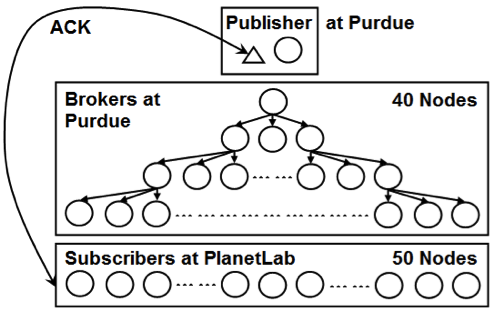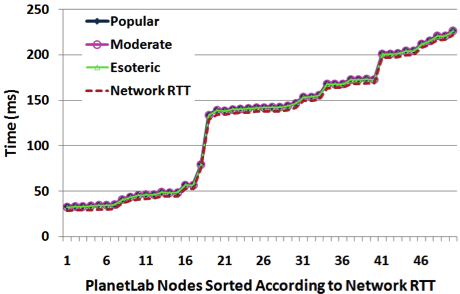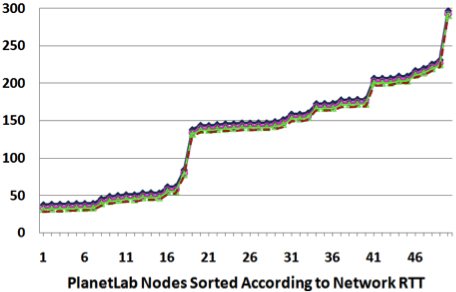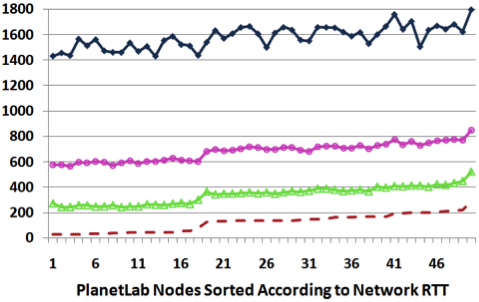We evaluated the performance of our protocols against baseline CBPS (Siena) with respect to end-to-end latency and computation time for notifications in a wide-area deployment. We implemented all the three protocols Baseline, RV, and SRV; and deployed them on PlanetLab, a worldwide computer systems testbed. Our experiments involve sending upto 100,000 subscription messages from the subscribers over a wide-area network, which, to the best of our knowledge, are the largest scale experiments on secure CBPS.
In our experiments, we created a hierarchical broker network with 4 levels (refer figure below). Each of the brokers in the top three levels were considered to have a fanout of 3, whereas, the leaf brokers were randomly connected to the subscribers. This constituted a broker network with 40 nodes. Each broker was hosted on a separate machine at Purdue University, 28 of which belonged to two clusters in our research group and the rest on public desktops in one of Purdue University laboratories. The subscribers were hosted on PlanetLab machines situated at widely varying geographical locations. We ran our experiments with upto 1000 subscribers hosted on 50 PlanetLab machines (i.e. 20 subscriber processes per machine). Each subscriber subscribed with 1-200 filters with a uniform random distribution, generating 100,000 subscriptions in our largest workload. In total, the experiments involved coordination between 1132 processes running on 91 machines over the Internet.

Our key observations from the experiments are presented below. All comparisons are done based on our largest workload, i.e. with 100,000 subscriptions, and hence are valid for smaller workloads.
- End-to-end latencies for baseline and RV are very similar. In baseline, end-to-end latency for all the nodes is within 5 ms of network RTT, whereas, in RV, this is within 10 ms of network RTT. End-to-end latency in SRV, is however significantly higher than network RTT. This happens due to large matching time at the brokers.
- Even with the largest workload, the difference in computational time between RV and baseline is only 3 ms. The computational cost for SRV is, however, 2 orders of magnitude higher than RV (600 ms in SRV as opposed to 6ms in RV for a moderately popular notification).
- SRV computation time at publisher for the largest workload is nearly 4 ms, which is insignificant compared to cost at brokers for SRV protocol. Therefore, our protocol does not impose much overhead on the publishers.
Based on our workload, message overhead per subscriber (i.e. extra bits added in header normalized by number of subscribers receiving a message) is only 4 Bytes. This shows the efficiency of our protocol in terms of network overhead.



c) SRV
It may be noted that in our current implementation, the leaf brokers are directly connected to subscribers and, therefore, have the potential to violate the anonymity requirements of the subscribers. To achieve subscriber anonymity from leaf brokers, we are currently implementing an anonymizing network between these entities. The nodes in this anonymizing network will have no notion of the filters but will act as proxies of the subscribers.

